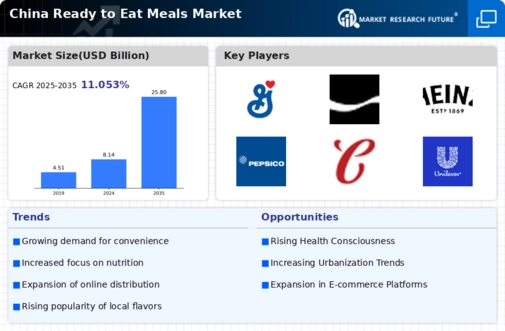Rising Disposable Income
The increase in disposable income among the Chinese population is contributing to the growth of the ready to-eat-meals market. As consumers have more financial resources, they are willing to spend on premium meal options that offer convenience and quality. This trend is particularly evident in urban areas, where disposable income has risen by approximately 20% over the past five years. The ready to-eat-meals market is capitalizing on this trend by offering gourmet and specialty meal options that appeal to affluent consumers. This willingness to invest in convenient meal solutions is likely to drive further growth in the market, as more individuals prioritize quality and convenience in their food choices.
Changing Dietary Preferences
The evolving dietary preferences among Chinese consumers are a key driver for the ready to-eat-meals market. With a growing awareness of health and nutrition, there is a noticeable shift towards plant-based and organic meal options. This trend is reflected in the increasing sales of vegetarian and vegan ready-to-eat meals, which have surged by 25% in recent years. Consumers are seeking meals that not only satisfy their hunger but also align with their health goals. The ready to-eat-meals market is adapting to these preferences by introducing diverse product lines that cater to various dietary needs, thus expanding its consumer base and enhancing market growth.
Urbanization and Lifestyle Changes
The rapid urbanization in China is reshaping consumer lifestyles, leading to an increased demand for convenience in food options. As more individuals migrate to urban areas, the need for quick and easy meal solutions becomes paramount. The ready to-eat-meals market is experiencing growth as busy professionals and families seek nutritious and time-saving alternatives. According to recent data, urban dwellers are more likely to spend on ready to-eat meals, with a notable increase of 30% in consumption over the past few years. This shift in lifestyle, characterized by longer working hours and less time for meal preparation, is driving the ready to-eat-meals market forward, as consumers prioritize convenience without compromising on quality.
Increased Focus on Food Safety and Quality
Food safety and quality have become paramount concerns for consumers in China, significantly influencing the ready to-eat-meals market. With rising awareness of foodborne illnesses and contamination, consumers are increasingly demanding transparency in food sourcing and production processes. This heightened focus on safety is prompting manufacturers to adopt stringent quality control measures and certifications. As a result, the ready to-eat-meals market is witnessing a shift towards products that emphasize high-quality ingredients and safe production practices. In 2025, it is anticipated that products meeting these safety standards will capture a larger market share, as consumers prioritize their health and well-being when selecting meal options.
Technological Advancements in Food Production
Technological innovations in food production and preservation are significantly impacting the ready to-eat-meals market. Advances in packaging technology, such as vacuum sealing and modified atmosphere packaging, enhance the shelf life and safety of meals, making them more appealing to consumers. Furthermore, automation in food processing has led to increased efficiency and reduced costs, allowing manufacturers to offer competitive pricing. In 2025, the market is projected to grow by 15% due to these technological improvements, as they enable companies to meet the rising demand for high-quality, ready-to-eat options. This evolution in food technology is crucial for the ready to-eat-meals market, as it aligns with consumer expectations for freshness and convenience.



















Leave a Comment